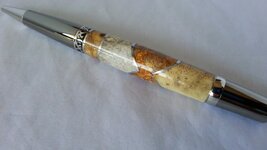Rosewood
Member
Yesterday,I attempted to glue up Walnut and Alum.. I scuffed the walnut and alum. what I thougt was real good. Rounded it down,attempted to drill for a tube and they came appart,at the glue line. I tried to do the same with a plastic C/C had the same results? The glue is about 1 1/2 years old,works on wood to wood,very well,no seperation. Stored in the ref. until use. New on on me,any help?

